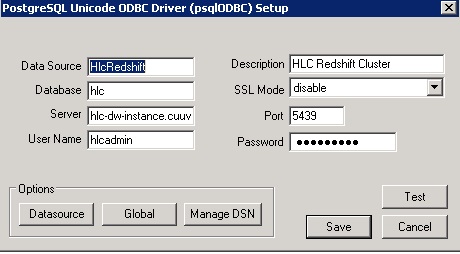
In the Solution Explorer, right-click on the SSIS Packages folder and select “New SSIS Package.” This will create a new package in your project. Step 1: Create an SSIS Project and Add a Data Flow Taskįirst, open SQL Server Data Tools (SSDT) and create a new Integration Services Project.

The process of extracting data from Redshift using SSIS with variables can be broken down into the following steps:
Odbc redshift driver#
Odbc redshift how to#
By the end of this tutorial, you will have a better understanding of how to use SSIS to extract data from Redshift and leverage variables to make your ETL processes more dynamic and efficient. This is a common challenge faced by data scientists and engineers who work with multiple data sources and need to integrate them for analysis and reporting purposes. In this blog post, we will explore how to extract data from Amazon Redshift using SQL Server Integration Services (SSIS) with variables. When you create the database link in dbForge Studio for Oracle, you can see your newly created link in Database Links on the left panel.| Miscellaneous Extracting Data from Amazon Redshift Using SSIS with Variables tns_name_entry is the Oracle Net connect descriptor specified in the tnsnames.ora file.
Odbc redshift plus#
To access an ODBC data source, you must create a database link using a database tool like SQL Plus or dbForge Studio for Oracle: connect to your database server and execute the CREATE DATABASE LINK statement, as follows: CREATE DATABASE LINK dblink CONNECT TO "username" IDENTIFIED BY "password" USING 'tns_name_entry' ĭblink is the complete database link name.

(ADDRESS = (PROTOCOL = tcp)(HOST = localhost)(PORT = 1521)) The SID must match the value specified in the listener.ora file. SID_LIST_LISTENER=Īdd a connect descriptor for the gateway to the tnsnames.ora file, which is located in ORACLE_HOME\NETWORK\ADMIN directory. To apply the new settings, stop and restart the Oracle Net Listener service. ORACLE_HOME is the Oracle home directory where the gateway resides. The SID of the gateway ( SID_NAME) must be the same in listener.ora and tnsnames.ora.

(ADDRESS = (PROTOCOL = TCP)(HOST = localhost)(PORT = 1521))Īdd an entry to the listener.ora file to start the gateway in response to connection requests. The following example is the address on which the Oracle Net Listener listens ( HOST is the address of the machine on which the gateway is installed): LISTENER = Information about the gateway must be added to the listener.ora configuration file which is located in the ORACLE_HOME\NETWORK\ADMIN\ directory. After creating the file, set the HS_FDS_CONNECT_INFO parameter to the system DSN that you created earlier, for example: HS_FDS_CONNECT_INFO=Amazon Redshift Configure Oracle Net ListenerĪfter configuring the gateway, you need to configure Oracle Net Listener to communicate with the Oracle database. You need a separate initialization file for each ODBC data source. The name must be prefixed with init - for example, initAmazon Redshift.ora.

To create an initialization file for the gateway, copy the sample initialization file and rename it. The sample file initdg4odbc.ora is stored in the ORACLE_HOME\hs\admin directory. Configure the Initialization FileĪfter installing the gateway and the ODBC driver for Amazon Redshift, create an initialization file for your Oracle Database Gateway for ODBC. The gateway can be installed on the machine running the non-Oracle system, the machine running the Oracle database or on a third machine as a standalone. The non-Oracle system can run on the same machine as the Oracle server or on a different machine. The driver must be installed on the same machine as the gateway. Any ODBC-compatible data source can be accessed using the gateway and the appropriate ODBC driver. The gateway works with an ODBC driver to access non-Oracle systems or other, remote Oracle servers. If your data is stored in a non-Oracle database system or cloud application, and you need to access it from an Oracle Database server, you can create a database link to an Oracle Database Gateway for ODBC. This article explains how to configure Oracle Database Gateway for ODBC. Configuring Oracle Database Gateway for ODBC


 0 kommentar(er)
0 kommentar(er)
